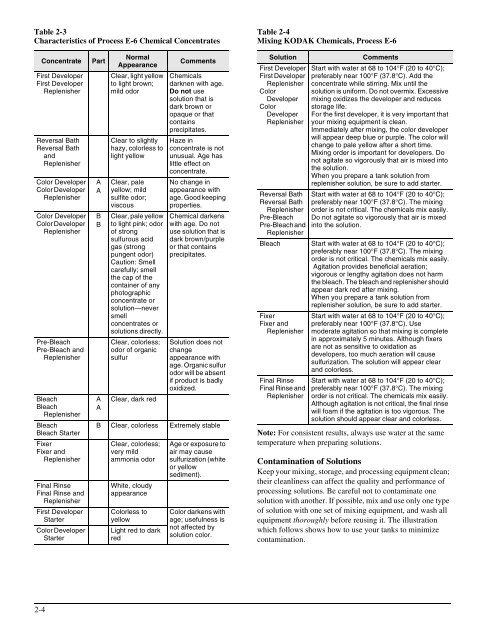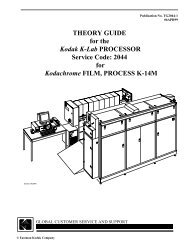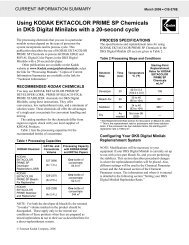2 chemicals and chemical mixing - 125px
2 chemicals and chemical mixing - 125px
2 chemicals and chemical mixing - 125px
You also want an ePaper? Increase the reach of your titles
YUMPU automatically turns print PDFs into web optimized ePapers that Google loves.
Table 2-3<br />
Characteristics of Process E-6 Chemical Concentrates<br />
2-4<br />
Concentrate Part<br />
First Developer<br />
First Developer<br />
Replenisher<br />
Reversal Bath<br />
Reversal Bath<br />
<strong>and</strong><br />
Replenisher<br />
Color Developer<br />
Color Developer<br />
Replenisher<br />
Color Developer<br />
Color Developer<br />
Replenisher<br />
Pre-Bleach<br />
Pre-Bleach <strong>and</strong><br />
Replenisher<br />
Bleach<br />
Bleach<br />
Replenisher<br />
Bleach<br />
Bleach Starter<br />
Fixer<br />
Fixer <strong>and</strong><br />
Replenisher<br />
Final Rinse<br />
Final Rinse <strong>and</strong><br />
Replenisher<br />
First Developer<br />
Starter<br />
Color Developer<br />
Starter<br />
A<br />
A<br />
B<br />
B<br />
A<br />
A<br />
Normal<br />
Appearance<br />
Clear, light yellow<br />
to light brown;<br />
mild odor<br />
Clear to slightly<br />
hazy, colorless to<br />
light yellow<br />
Clear, pale<br />
yellow; mild<br />
sulfite odor;<br />
viscous<br />
Clear, pale yellow<br />
to light pink; odor<br />
of strong<br />
sulfurous acid<br />
gas (strong<br />
pungent odor)<br />
Caution: Smell<br />
carefully; smell<br />
the cap of the<br />
container of any<br />
photographic<br />
concentrate or<br />
solution—never<br />
smell<br />
concentrates or<br />
solutions directly.<br />
Clear, colorless;<br />
odor of organic<br />
sulfur<br />
Clear, dark red<br />
Comments<br />
Chemicals<br />
darknen with age.<br />
Do not use<br />
solution that is<br />
dark brown or<br />
opaque or that<br />
contains<br />
precipitates.<br />
Haze in<br />
concentrate is not<br />
unusual. Age has<br />
little effect on<br />
concentrate.<br />
No change in<br />
appearance with<br />
age. Good keeping<br />
properties.<br />
Chemical darkens<br />
with age. Do not<br />
use solution that is<br />
dark brown/purple<br />
or that contains<br />
precipitates.<br />
Solution does not<br />
change<br />
appearance with<br />
age. Organic sulfur<br />
odor will be absent<br />
if product is badly<br />
oxidized.<br />
B Clear, colorless Extremely stable<br />
Clear, colorless;<br />
very mild<br />
ammonia odor<br />
White, cloudy<br />
appearance<br />
Colorless to<br />
yellow<br />
Light red to dark<br />
red<br />
Age or exposure to<br />
air may cause<br />
sulfurization (white<br />
or yellow<br />
sediment).<br />
Color darkens with<br />
age; usefulness is<br />
not affected by<br />
solution color.<br />
Table 2-4<br />
Mixing KODAK Chemicals, Process E-6<br />
Solution Comments<br />
First Developer<br />
First Developer<br />
Replenisher<br />
Color<br />
Developer<br />
Color<br />
Developer<br />
Replenisher<br />
Reversal Bath<br />
Reversal Bath<br />
Replenisher<br />
Pre-Bleach<br />
Pre-Bleach <strong>and</strong><br />
Replenisher<br />
Start with water at 68 to 104°F (20 to 40°C);<br />
preferably near 100°F (37.8°C). Add the<br />
concentrate while stirring. Mix until the<br />
solution is uniform. Do not overmix. Excessive<br />
<strong>mixing</strong> oxidizes the developer <strong>and</strong> reduces<br />
storage life.<br />
For the first developer, it is very important that<br />
your <strong>mixing</strong> equipment is clean.<br />
Immediately after <strong>mixing</strong>, the color developer<br />
will appear deep blue or purple. The color will<br />
change to pale yellow after a short time.<br />
Mixing order is important for developers. Do<br />
not agitate so vigorously that air is mixed into<br />
the solution.<br />
When you prepare a tank solution from<br />
replenisher solution, be sure to add starter.<br />
Start with water at 68 to 104°F (20 to 40°C);<br />
preferably near 100°F (37.8°C). The <strong>mixing</strong><br />
order is not critical. The <strong><strong>chemical</strong>s</strong> mix easily.<br />
Do not agitate so vigorously that air is mixed<br />
into the solution.<br />
Bleach Start with water at 68 to 104°F (20 to 40°C);<br />
preferably near 100°F (37.8°C). The <strong>mixing</strong><br />
order is not critical. The <strong><strong>chemical</strong>s</strong> mix easily.<br />
Agitation provides beneficial aeration;<br />
vigorous or lengthy agitation does not harm<br />
the bleach. The bleach <strong>and</strong> replenisher should<br />
appear dark red after <strong>mixing</strong>.<br />
When you prepare a tank solution from<br />
replenisher solution, be sure to add starter.<br />
Fixer<br />
Fixer <strong>and</strong><br />
Replenisher<br />
Final Rinse<br />
Final Rinse <strong>and</strong><br />
Replenisher<br />
Start with water at 68 to 104°F (20 to 40°C);<br />
preferably near 100°F (37.8°C). Use<br />
moderate agitation so that <strong>mixing</strong> is complete<br />
in approximately 5 minutes. Although fixers<br />
are not as sensitive to oxidation as<br />
developers, too much aeration will cause<br />
sulfurization. The solution will appear clear<br />
<strong>and</strong> colorless.<br />
Start with water at 68 to 104°F (20 to 40°C);<br />
preferably near 100°F (37.8°C). The <strong>mixing</strong><br />
order is not critical. The <strong><strong>chemical</strong>s</strong> mix easily.<br />
Although agitation is not critical, the final rinse<br />
will foam if the agitation is too vigorous. The<br />
solution should appear clear <strong>and</strong> colorless.<br />
Note: For consistent results, always use water at the same<br />
temperature when preparing solutions.<br />
Contamination of Solutions<br />
Keep your <strong>mixing</strong>, storage, <strong>and</strong> processing equipment clean;<br />
their cleanliness can affect the quality <strong>and</strong> performance of<br />
processing solutions. Be careful not to contaminate one<br />
solution with another. If possible, mix <strong>and</strong> use only one type<br />
of solution with one set of <strong>mixing</strong> equipment, <strong>and</strong> wash all<br />
equipment thoroughly before reusing it. The illustration<br />
which follows shows how to use your tanks to minimize<br />
contamination.

















